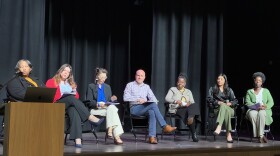The March 5 primary was North Carolina’s first statewide election under a new photo ID law — nearly six years after voters approved a constitutional amendment requiring it.
This week, the state board of elections released data on how many people’s ballots weren’t counted because they didn’t have a photo ID. The board also released information to WFAE on the voter’s political party, race and ethnicity.
WFAE reporter Steve Harrison spoke with All Things Considered host Nick De La Canal about who was impacted by the law.
Nick De La Canal: Steve, before we get into the numbers, tell me a little bit about North Carolina’s tortured history with photo ID and why this matters so much.
Steve Harrison: Ok, history lesson here: For more than a decade, North Carolina Republicans have tried to make photo ID a requirement to vote. And for a decade, it’s been a national news story, given how close the state is in presidential elections.
The first attempt, from 2013, was overturned by a federal court, which famously said that the first photo ID law targeted Black voters with “almost surgical precision.”
Republicans then placed a constitutional amendment on the ballot in 2018, which voters approved by a wide margin. And then they passed a law implementing photo ID that allowed voters to use more types of identification.
But people still filed lawsuits arguing it would unfairly impact African-American voters.
De La Canal: So the state Supreme Court — now with a Republican majority — ruled last year that it was constitutional. That cleared the way for it to be required for 2024.
Harrison: Exactly. There were municipal elections last fall requiring photo ID, but the March primary was the first big statewide test.
De La Canal: Walk me through what happens at the polls when you don’t have an ID.
Harrison: You are given what’s known as a photo ID exception form. You can check a number of boxes as to why you don’t have an ID — things like you didn’t have transportation to get it, or even you lost it.
Then you cast a provisional ballot, which, in almost all cases, counts after your county board of elections reviews it.
And you can cast a provisional ballot without filling out the exception form, but if you want it to count, you have to go back to your county boards of elections office and show them a photo ID.
De La Canal: OK, let’s run through the numbers.
Harrison: 1.8 million people cast ballots in the primary.
1,185 voters cast provisional ballots because they didn’t have a photo ID at the polls. Most of those people filled out the photo ID exception form at the polls, and their ballots were ultimately counted.
But 473 people did not have their ballots counted. Most of them did not fill out that exception form.
De La Canal: Now let’s look at who those 473 people are. What can you tell me?
Harrison: This is very interesting, I think.
For the last decade, the main thrust of the litigation against photo ID was that Republicans were using it to suppress Democratic votes.
But in the primary, 174 Republican voters had their provisional ballots not counted because they didn’t have photo ID. On the Democratic side, there were 171 voters whose ballots didn’t count.
De La Canal: So a tie, really, but technically three more Republicans than Democrats. What about race and ethnicity?
Harrison: 298 white voters had their provisional ballots not counted because they lacked photo ID, compared with 74 Black voters, seven multi-racial voters and 10 Asian voters.
Most of the remaining voters did not disclose their race when they registered.
The board of elections has not released the entire voter file from the primary, so we don’t know how many white and Black voters there were overall. And that makes it impossible to determine the exact rate of thrown-out ballots.
But we can get a snapshot: In North Carolina, there are a little more than three times as many white voters as Black voters. And in this election, white voters had four times as many disqualified provisional ballots as African-Americans.
So at first glance, Black voters were not impacted more severely than white voters.
De La Canal: One thing these numbers don’t capture — there’s no way to know if someone just didn’t come out to try and vote because they knew they didn’t have a photo ID right?
Harrison: That’s true. We can’t measure whether someone decided to just skip going to the polls altogether.
De La Canal: OK, Steve, what’s next for photo ID?
Harrison: That tortured path you mentioned — it’s still not over. There is a trial in federal court coming up in May. The NAACP has sued over photo ID.
And it’s possible the Republicans in the General Assembly could take a second look at that photo ID exception form, making it harder for people to use, or even getting rid of it entirely. House Speaker Tim Moore has said he thinks it’s too lenient.








